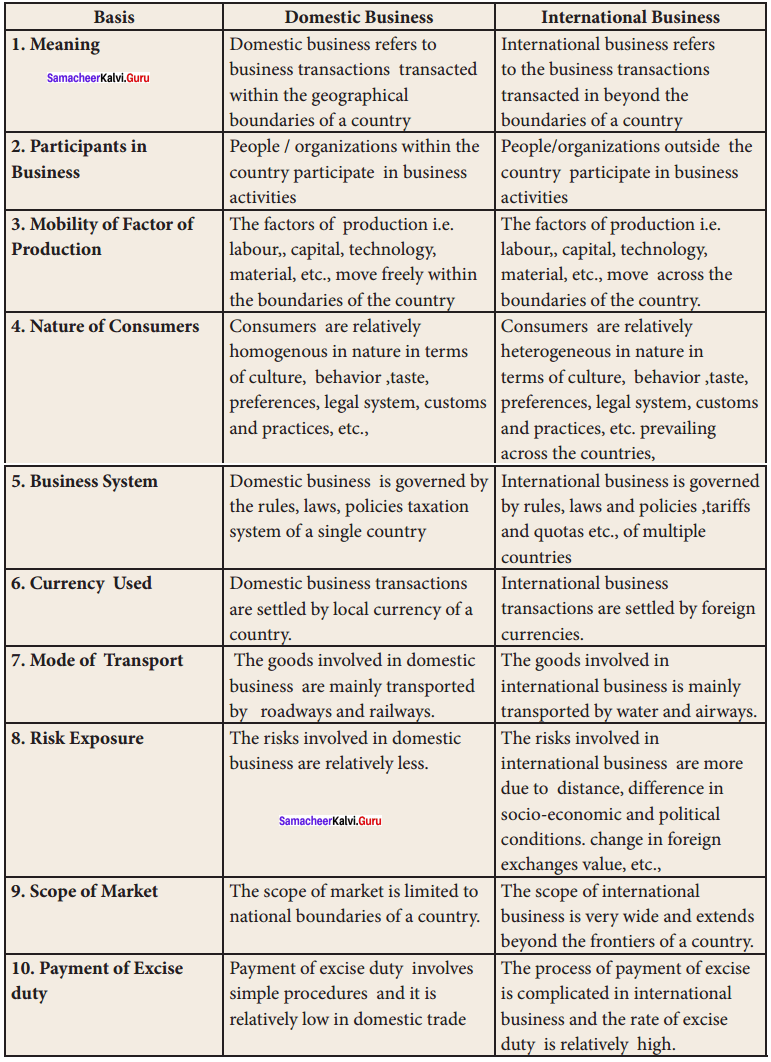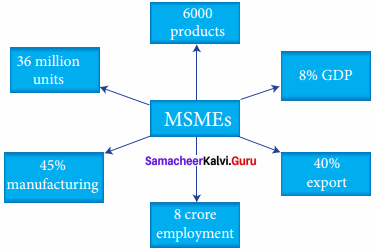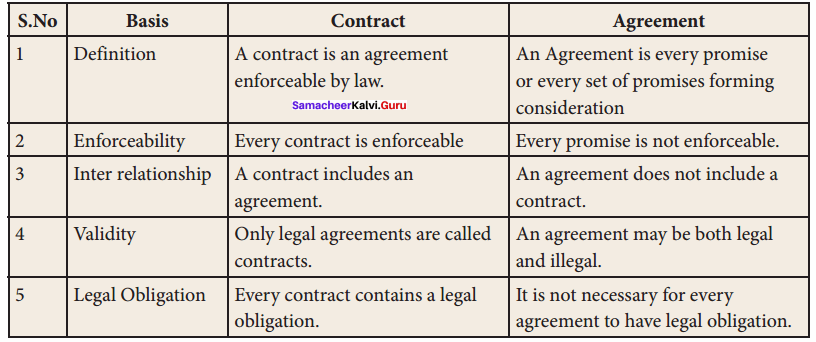Students can Download Commerce Chapter 16 Emerging Service Business in India Questions and Answers, Notes Pdf, Samacheer Kalvi 11th Commerce Book Solutions Guide Pdf helps you to revise the complete Tamilnadu State Board New Syllabus and score more marks in your examinations.
Samacheer Kalvi 11th Commerce Solutions Chapter 16 Emerging Service Business in India
Samacheer Kalvi 11th Commerce Emerging Service Business in India Textbook Exercise Questions and Answers
I. Choose the Correct Answer
Question 1.
A continuing relationship which provides a licence privileges do business and provides training, merchandising for a consideration is called …………….
(a) Franchising
(b) Factoring
(c) supply chain management
(d) Exchange
Answer:
(a) Franchising
Question 2.
A condition were a factors agrees to provide complete set of services like financing, debt collection, consultancy is called …………….
(a) Maturity factoring
(b) National factoring
(c) Full service factoring
(d) Recourse factoring
Answer:
(c) Full service factoring

Question 3.
Buying and selling ofgoods through electronic network is known as …………….
(a) E – commerce
(b) Internet
(c) Website
(d) Trade
Answer:
(a) E – commerce
Question 4.
An organization carrying out activities to move goods from producer to consumer is …………….
(a) Transport
(b) Logistics
(c) Channels
(d) Marketing
Answer:
(a) Transport
Question 5.
The role of government in logistics management is through …………….
(a) Legislations
(b) Governance
(c) Transport
(d) Distribution
Answer:
(d) Distribution
Question 6.
The main benefit of Logistics is …………….
(a) productivity
(b) Cost minimisation
(c) Profitability
(d) Storage
Answer:
(b) Cost minimisation
Question 7.
What aims for an effective management response over the longer run …………….
(a) Logistics
(b) Supply Chain Management
(c) Demand
(d) Supply
Answer:
(a) Logistics
Question 8.
The model that identifies alternatives, criteria for decision making and analyse alternatives to arrive at the best choice is …………….
(a) Routing model
(b) Scheduling model
(c) Inventory model
(d) Alternative Analysis
Answer:
(b) Scheduling model

Question 9.
A company under outsourcing transfers activities which are …………….
(a) Core
(b) Non – Core
(c) Business
(d) Non – Business
Answer:
(b) Non – Core
Question 10.
Business units can reduce expenditure by outsourcing front office work like ……………..
(a) Paper work
(b) file work
(c) Billing
(d) manufacture
Answer:
(b) file work
Question 11.
The main benefit of outsourcing is …………….
(a) Productivity
(b) Cost reduction
(c) Skill
(d) Units
Answer:
(b) Cost reduction
Question 12.
Outsourcing job is given to developing countries specifically for …………….
(a) Cheap labour
(b) Land
(c) Capital
(d) Factors
Answer:
(a) Cheap labour
Question 13.
Outsourcing is carried out for the benefit of …………….
(a) Global village
(b) Transport
(c) Factory
(d) Time and money
Answer:
(d) Time and money
II. Very Short Answer Questions
Question 1.
Who is a franchisee?
Answer:
The individual who acquires the right to operate the business or use the trademark of the seller is known as the franchisee.
Question 2.
State two disadvantages of franchising?
Answer:
Franchising fees: The initial franchising fee and the subsequent renewal fee can be very high in the case of successful businesses. From the franchisee’s point of view, this may be a deterrent. Fixed royalty payment: The franchisee has to make payment of royalty to the franchiser on a regular basis. This considerably reduces the income of the franchisee.
Question 3.
Who is a factor?
Answer:
The factor is an agent who buys the accounts receivables (Debtors and Bills Receivables) of a firm and provides finance to a firm to meet its working capital requirements.

Question 4.
Define outsourcing.
Answer:
BPO refers to outsourcing the work which is routine in nature, to an outside agency.
Question 5.
What is the need for outsourcing?
Answer:
- To obtain the benefit of specialization
- To reduce the cost
- To increase profit
- To cater to the dynamic demand
Question 6.
State the importance of BPO.
Answer:
BPO means getting contractual services of external companies or group of companies to complete special work or process of a company. For example call centres, data entry etc. This reduces the expenditure by using cheap labour available in developing countries like India, China etc.
Question 7.
What are the benefits of KPO?
Answer:
- It helps in the usage of the best skills
- It produces ultimate use of knowledge
- It helps in finding a solution to a complex problem
- It leads to a reduction of expenditure
Question 8.
Define Logistics.
Answer:
Logistics can be viewed as a logical extension of transportation and related areas to achieve an efficient and effective goods distribution system.
Question 9.
What is the need for Logistics?
Answer:
Logistics are needed in the following factors.
The following are the need for logistics:
- Development of the systems approach and total cost analysis concepts.
- Markets, and logistics policies and practices of suppliers of consumer products, being driven by the large retailers.
- Customer service activities continuing to be centralized and consolidated.
Question 10.
Write about the importance of Logistics.
Answer:
Organizations taking proactive managerial attention in coordinating the actors in logistics leads to reduced logistics costs and improved customer service.

Question 11.
What are the types of Logistics Applications?
Answer:
- Decision – wise
- Actor – wise
- Inbound logistics
- Outbound logistics
Question 12.
What do you mean by E-commerce?
Answer:
E-Commerce is the process of buying and selling goods and services through electronic networks like the internet. It denotes the external transactions.
III. Short Answer Questions
Question 1.
What are the types of franchising?
Answer:
1. Product/ trade name franchising:
In this type, the franchisee exclusively deals with a manufacture’s product. Examples include Kidzee, French loaf outlets, Bharat Petroleum bunks, Patanjali products, etc. Relationships like Maruti Suzuki with ABT Maruti or Hero Honda bike dealerships may be considered as franchises. However, they but should be considered more as exclusive dealerships with more operational freedom for the dealers.
2. Business format franchising:
When a franchisor awards rights covering all business aspects as a complete called business format franchising. This package includes training, support, and the corporate name. This enables uniformity of products, services, environment across geographical boundaries with a high degree of standardization. Examples are McDonald’s, Pizza Hut. KFC, Hot bread, Titan, Color plus, Zodiac, Lakme beauty parlour.
Question 2.
List the steps in the factoring process.
Answer:
- The firm enters into a factoring arrangement with a factor, which is generally a financial institution, for invoice purchasing.
- Whenever goods are sold on a credit basis, an invoice is raised and a copy of the same is sent to the factor.
- The debt amount due to the firm is transferred to the factor through the assignment and the same is intimated to the customer.
Question 3.
Describe the benefits of Logistics.
Answer:
- Logistics reduce overall logistics costs
- It avoids the distribution of infrastructure investment.
- It helps in avoiding systems investments.
- It helps in sharing freight costs.
- It helps in reducing liability in freight operations.
- It leads to quick access to new markets.
Question 4.
Explain the points of differences between Logistics and Supply Chain Management.
Answer:
Logistics:
Logistics Management deals with the efficient management of a static gap between demand and supply.
Supply Chain Management:
Supply Chain Management tries to identify the dynamic nature of the value creation itself such as responsiveness, quality, and design. Hence, it aims for an effective management response over the longer run.
Question 5.
What is the impact of e-commerce on buyers?
Answer:
- Buyers could have global access to information about a variety of products and services available in the market
- They could buy the products/services round the clock from anywhere in the world.
- The prices of products bought through e-commerce tend to be relatively lower than those purchased physically in the conventional shops due to offers, discounts, etc.
- Electronic and software products could be downloaded immediately after purchase through e-commerce mode.
- Customers could participate in e-auction which is one of the facets of e-commerce and get a contract in a free and fair manner.
- Individuals could sell their used products through e-commerce mode with relative ease.
- Buyers can bargain and negotiate better terms and conditions with respect to buying knowledge products.
IV. Long Answer Questions
Question 1.
Enumerate the characteristics of franchising.
Answer:
Meaning: The practice of the right to use a firm’s business model and brand for a prescribed period of time.
- A franchise relationship is based on an agreement which lays down the terms and conditions of this relationship.
- The term of the franchise may be for 5 years or more. The franchise agreement may be renewed with the mutual consent of the parties.
- The franchisee gives an undertaking not to carry any other competing business during the term of the franchise, and the franchiser gives an undertaking not to terminate the franchise agreement before its expiry except under situations that may justify the termination of the franchise agreement.
- The franchisee agrees to pay specified royalty to the franchiser, as per the terms of the franchise agreement.
- Franchise means selling the same product and maintaining a similar type of shop decor (i.e. style of interior decoration) for which the franchiser provides assistance to the franchisee in organizing, merchandising, and management. The franchiser virtually sets up the business for the franchisee.
- The franchisee is supposed to follow the parent, company’s policies regarding the mode of business operations, as per clauses in the franchise agreement.
- Franchisers may give training to personnel working in the franchisee’s organization.

Question 2.
Elucidate the features of factoring.
Answer:
- Maintenance of book – debts: A factor takes the responsibility of maintaining the accounts of debtors of a business institution.
- Credit coverage: The factor accepts the risk burden of loss of bad debts leaving the seller to concentrate on his core business
- Cash advances: Around eighty percent of the total amount of accounts receivables is paid, as advance cash to the client.
- Collection service: Issuing reminders, receiving part payments, collection of cheques from part of the factoring service.
- Advice to clients: From the past history of debtors, the factor is able to provide advice regarding the creditworthiness of customers, perception of customers about the products of the client, etc.
Question 3.
Describe the benefits of Outsourcing.
Answer:
- Focusing on Core Activities: Companies can focus on their core competence, a few areas where the company has a distinct capability. The rest of the activities (noncore) can be outsourced to outside agencies.
- To Fill up Economic Development Outsourcing stimulates entrepreneurship, encourages employment opportunities, expands exports, enables tremendous growth of the economy.
- Encourages Employment Opportunities: Companies that are outsourcing their noncore activities provide chances for other small business units to take up the activities. This paves way for more job opportunities and new employment avenues.
- Reduction in Investment: Companies through outsourcing avail the services of outsiders which in turn reduces the investment requirements. The amount so available can be utilized productively and this increases the profits.
- Quest for Excellence: Outsourcing enables the firms to pursue excellence in two ways namely excelling themselves in the activities they do and excel outsiders by extending their capabilities through contracting out.
Question 4.
Explain the points of differences between BPO and KPO.
Answer:
BPQ:
- BPO means getting contractual services of external companies or groups of companies to complete the special work or process of a company.
- For example call centres, data entry, etc. This reduces the expenditure by using cheap labour available in developing countries like India, China, etc.
- To focus on key functions.
- The benefit of specialization/efficiency.
- Cost-cutting.
KPO:
- KPO refers to the outsourcing of Knowledge-based Processes. It means obtaining high-end knowledge work from outside the organization in order to run the business successfully and in a cost-effective manner.
- In short KPO firms get knowledge related, information related, work done from the outside firm and it involves high-value work carried highly skilled staff.
- Usage of best skills.
- The ultimate use of knowledge.
- Finding a solution to a complex problem.
Question 5.
Write a note on e-commerce models.
Answer:
Business to Customers (B 2 C):
This is the fastest-growing segment in e-commerce spare. Under this model, business concern sells directly to consumers.
Business to Business (B 2 B):
Under the model, business concerns transact with one another through the internet. For instance, Snapdeal, Flipkart, Alibaba, Indiamart, Trade India. Com etc.
Consumer to Consumer (C 2 C):
Under this model, customers sell directly to other customers through online classified advertisement or through auction or through mobile or through market places. Example. Indian ventures in C 2 C are Kraftly App (buying and selling anythings) which deals in handmade products of a wide range. Once again store. Com is a website that buys pre-owned women’s fashion products. Other players are quikr, olx, eBay etc.
Customer to Business ( C 2 B):
This model is reverse to the auction model. Products like automobiles, electronic items furniture, and similar product are traded by customers through websites. Example Naukri.com and Monster.com are examples of Indian companies operating in this domain
Business to Government ( B 2 G):
This model envisages selling products and services by the business consumers to Government organizations. For instance, TCS operates the passport application process for the Government of India as a part off-line process.
Samacheer Kalvi 12th Commerce Emerging Service Business in India Additional Questions and Answers
I. Choose the Correct Answer:
Question 1.
There are …………….. parties to a franchising agreement.
(a) two
(b) Three
(c) Four
(d) Five
Answer:
(a) two
Question 2.
There are …………….. types of franchising primarily.
(a) One
(b) Two
(c) Three
(d) Four
Answer:
(b) Two

Question 3.
Factoring means ……………..
(a) to make or do
(b) to work
(c) for credit
(d) for debit
Answer:
(a) to make or do
Question 4.
…………….. focuses on profit maximization rather than cost-minimizing.
(a) SMC
(b) LM
(c) Transportation
(d) GST
Answer:
(a) SMC
Question 5.
Recently a new type of business in the service sector is called ……………..
(a) BPO
(b) core
(c) non – core
(d) gardening
Answer:
(a) BPO
Question 6.
Business to Business (B2B) ……………..
(a) Snapdeal
(b) Monster.com
(c) TCS
(d) ebay
Answer:
(a) Snapdeal
Question 7.
Customer to Business (C2B) ……………..
(a) Flipkart
(b) Indiamart
(c) Olx
(d) Naukri.com
Answer:
(d) Naukri.com
II. Very Short Answer Questions
Question 1.
What is E-Business?
Answer:
E-Business is a broader term which includes an internal and external transaction of an organization across the internet.
Question 2.
What do you mean by Business to Customers (B2C)?
Answer:
This is a faster-growing segment in e-commerce spare. Under this model, business concern sells directly to customers.

Question 3.
Mention any two advantages of franchising.
Answer:
- Reduces risk
- Business expansion.
III. Short Answer Questions
Question 1.
What is the impact of e-commerce on vendors?
Answer:
- Vendors could have wider access to customers across the globe.
- This helps minimize the cost of operating business due to the direct distribution of goods to end consumers thanks to the minimum invention of intermediaries.
- The vendor could interact with multiple buyers and sellers.
For Future Learning
Question a.
You are a small scale manufacturer of ignition coils for automobiles, located near Ranipet. Explain how will you avail of financial credits through factoring if you get orders from
a. Ford India, Chennai
b. Maruti Suzuki, Gurgaon
c. Kun Hyundai, Seoul
Answer:
a. I can show the sources of business to get credit.
b. Maruti Suzuki, Gurgaon
- To identify the activities involved in the movement of goods – Trade
- To analyze the benefits of Logistics – Transport
- To evaluate the areas which need more focus relating to Logistics – Kinds of transport
- To understand critically and analyze the impact of Logistics on Profitability – To reduce cost and improve customer service.
c. Kun Hyundai, Seoul
- To identify the core activities of any business – Companies can focus on their core competence.
- To analyze the benefits of Outsourcing non – core items – Outsource to outside agents.
- To evaluate the areas which need KPO – KPO firm get knowledge related, information related work done from an outside firm.
- To understand critically and analyze the impact of call centers
![]()
![]()
![]()
![]()





